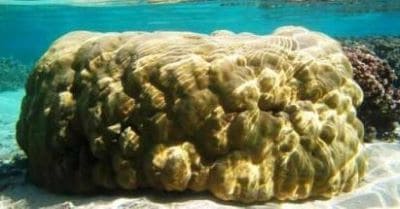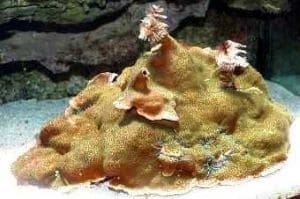Home › Sea Life Animals and Plants › Coral Formations › Porites
Finger Coral Facts and Information
[Phylum: Cnidaria] [Class: Hexacorallia] [Family: Poritidae (stony coral)] [Genus: Porites]
Porites coral, of the genus scleractinia (meaning stony coral), is also known as finger coral (scientific name Porites compressa), boulder coral, and sometimes hump coral.
This finger-like characterisation and morphology is typical of the Porites species that create colonial rings of corals (microatoll formations) and large sturdy habitats for Spirobranchus giganteus.
Branching Finger Coral: Range and Habitat
For the most part, Porites corals are found at the reefs of warm water ecosystems around the world, especially:
- The Great Barrier Reef (Australia)
- Indo-Pacific (e.g. Indonesia, Malaysia, Philippines)
- Shallow basins of the Caribbean Sea
- Western parts of the Atlantic Ocean
In particular, Porites lutea coral species (pictured below) are found in fringing reefs and the lagoons of inter-tidal habitats.
Whereas other types of corals, such as the massive colonies formed by Porites pukoensis, thrive better in shallow protected reef environments of the Pacific Ocean (e.g. Molokai Island, Hawaii).
Facts about Finger Coral Porites
Some of the smooth textured yellow or buff coloured stone structures of finger corals (Porites porites) can grow up to five (5) metres across (16 feet).
Most of them are hemispherical in shape (like a large concave bowl), and they represent the most prodigious of all stony coralline formations.
Despite an exceptionally sluggish growth rate, often less than one centimetre per year for some branching porites, the giants of seven or eight metres high rank among the oldest and most established of all earth life forms.
The small polyp stony (SPS) corals are mostly a finger-like species, commonly found colonising clear-water shallow reefs in tropical ecosystems. Typical examples include the dive sites in Thailand, Malaysia, Indonesia, Vietnam, and The Philippines.
Pro Tip: Some Porites species have mucus covering the colonies. This coral surface mucus layer (SML) helps them to feed, it protects them against harmful pathogens, and it means they can survive in some rocky, or sedimentary, environments.
Porite Coral Description and Shape
These large coral colonies may appear to be one single structure. But, they are a skeleton of countless "anemone-like" animals.
 Often called the "Jeweled Finger", each colony of coral polyps displays finger-like morphology that develops from a singular base framework.
Often called the "Jeweled Finger", each colony of coral polyps displays finger-like morphology that develops from a singular base framework.
Here's the thing:
Finger coral porites differ in shape and appearance. Some of the important reef producing corals are flat and featureless.
Whereas, others are hemispherical, like a saucer, or almost completely spherical.
On top of that, some have branching tentacles which appear to be somewhat tree-like both in form and in stature and provide ideal habitats for the Christmas tree worm phylum (S. giganteus).
What Do Porites Eat?
The tissues of coral polyps contain zooxanthellae, which produce nutrition. In return, the microscopic algae benefit from safe access to strong sunlight.
How do Porite Corals Reproduce?
Most coral species are hermaphrodites (they possess male and female reproductive organs). Yet, male and female Porites corals exist in colonies separate from one another.
The free-swimming male sperm needs to reach the female colony for fertilisation to be successful. Larvae develop inside the female's cavity until the brooding corals are released to settle in the nearby environment.
Threats and Predators
Like most of the earth's coral species, Porites continue to suffer the effects of ocean pollution, devastating starfish invasions, and climate change.
The main difference is the time they need to recover from existential threats. Their slow recovery rate threatens the long term survival of the entire species, if current global trends remain unchanged.
But wait - there's more:
Sadly, Porites have another wide-ranging threat to cope with. Worldwide collections of live (and dead) corals have lowered in recent years.
But, the aquarium trade and biomedical industry still add to the global threat to sustainable coral reef ecosystems around the world.
Some protection and part of the solution could be the recent regulatory improvements regarding the International trade in endangered species (CITES) and marine protected areas (MPA).
Pro Tip: Our hobby section explains how to improve pet fish health with extra information about Porites coral care when setting up a home aquarium.
Related Information and Help Guides
 Coral Reef Formations: Importance of Reef Producing Corals
Coral Reef Formations: Importance of Reef Producing Corals- What Causes Coral Bleaching and How Can We Stop it?
- How Do Artificial Reefs Help Nature Restore Itself?
- Facts and Information about Different Types of Coral Diseases
- How Do Tiny Polyps Produce Coral Reefs?
- Fun and Interesting Facts about Staghorn Corals
- What are Corals Made Of and are they Animals or Plants?